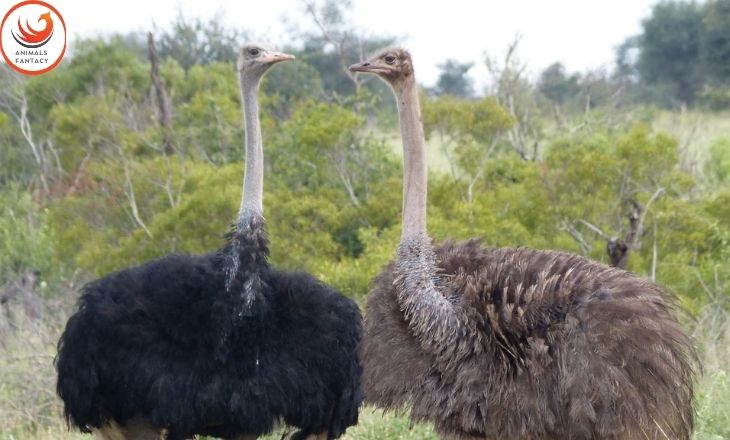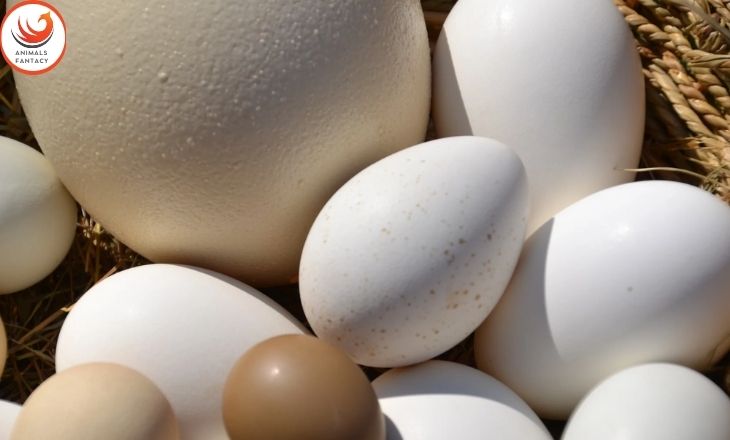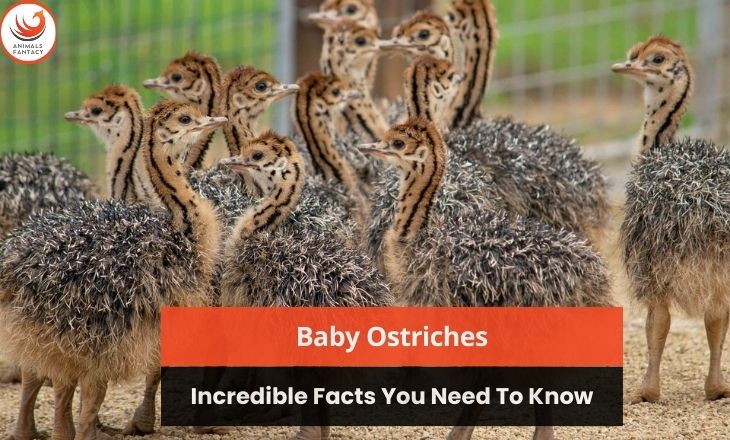Nestled within the vast savannas of Africa, baby ostriches emerge into the world as fascinating and endearing creatures that defy their towering relatives with their charm. These fluffy little bundles of curiosity captivate our hearts and pique our interest with their unique characteristics and behaviours.
From their oversized eyes that seem to hold ancient wisdom to their comical antics as they navigate the world on gangly legs, ostrich chicks offer a delightful glimpse into the intricate tapestry of nature’s wonders.
What Does A Baby Ostrich Look Like?
A baby ostrich is a fluffy little bird covered in soft down feathers ranging from light grey to yellowish-brown. Despite their small size, ostrich chicks already show the distinctive long legs they will use to run at incredible speeds as adults.
They have large, expressive eyes that give them a curious and endearing look. Their tiny beaks are specially adapted for picking food on the ground and communicating with their parents and siblings through various chirps and calls. As they age, these chick feathers will gradually change to adult ostriches’ sleek black or grey plumage.
How Big Are Baby Ostriches?
Compared to adult ostriches, their tiny size means they can stand up and explore their surroundings within hours of birth. These fluffy little birds can grow rapidly in the first few months of life, reaching heights of around 10 inches when they are just one month old.
Their growth rate is remarkable, as baby ostrichs can gain nearly a foot in height every month during their early stages of development. Watching young ostriches chicks quickly transform into tall and leggy birds that will eventually become the world’s largest and fastest land animals is fascinating.
How Much Does Baby Ostrich Weigh?
They are born weighing about 2.5 to 4 pounds, making them relatively lightweight compared to their enormous adult counterparts. Ostrich chicks grow rapidly and can gain up to 1 pound daily during the first few months. This rapid growth is essential for developing the strength and size needed to survive in the wild.

The weight of ostrich chicks plays a crucial role in their ability to keep up with their parents and navigate their surroundings effectively. As they continue to grow, their weight increases significantly, eventually reaching around 220 pounds by the time they reach adulthood.
What Do Juvenile Ostriches Look Like?
Juvenile ostriches, whether male or female, exhibit similar physical characteristics.
Juvenile Male Ostriches:
Juvenile male ostriches, known as “cockerels“, display brown and white feathers with a subtle hint of black. Their plumage is less vibrant than adult males, but they still possess the species’ distinctive long neck and large eyes.
As they mature, their feathers gradually transition into the iconic black-and-white pattern distinguishing them in adulthood.
Juvenile Female Ostriches:
Juvenile female ostriches, or “pullets“, feature a more muted colour palette with shades of grey and brown dominating their plumage coloration. Their appearance is notably different from adult females due to their lack of distinct colouring on their necks and legs.
Female ostriches transform as they age and develop the striking mixture of grey, white, and black feathers that symbolize femininity in mature individuals.

What Is A Baby Ostrich Called?
Baby ostrich are known as chicks, just like young chickens. These adorable creatures hatch from eggs incubated by their mother in a carefully constructed nest made of sand and loose vegetation.
Once hatched, the chicks rely on their parents for warmth and protection until they are old enough to fend for themselves in the wild. Being born with long legs and large eyes, ostrich chicks are surprisingly vulnerable to predators such as jackals and eagles.
They stay close to their parents for the first few months of their lives, learning essential survival skills through observation and practice. With their fluffy feathers and curious nature, baby ostrich chicks captivate the hearts of all who encounter them in the vast savannas of Africa.
What Is A Group Of Baby Ostrichs Called?
A group of baby ostrich is known as a “brood“. These adorable fluffy youngsters are usually watched over by the adult female ostriches, also known as hens, who fiercely protect them against predators. Where males play a significant role in rearing offspring, male ostriches are less involved in caring for the young ones.
As baby ostrichs grow and mature, they eventually join groups with other juveniles or young adults, forming a “herd“. In these herds, young ostriches learn important skills and behaviours from each other while gaining independence from their mothers.
What Do Ostrich Chicks Eat?
Baby ostrich have a diverse diet of plants, insects, and small vertebrates. While primarily feeding on green vegetation like grass and leaves, they consume seeds, fruits, and flowers to supplement their nutrition.
Insects such as beetles, ants, and termites are an essential source of protein for baby ostriches as they help their growth and development. Ostriches also eat small animals like lizards or rodents when the opportunity arises.
This behavior showcases their adaptability to different food sources in their environment. Chicks of ostriches rely on pebbles and stones to grind down their food in the gizzard since they lack teeth for chewing. This unique feeding behaviour helps them digest tough plant materials efficiently.
Do Both Parents Feed Ostrich Chicks?
The female is responsible for incubating the eggs during the day, and the male takes over at night, ensuring continuous warmth and protection. Both parents provide food to their young. This shared responsibility highlights ostriches’ strong parental bond towards their offspring.
Ostrich chicks form communal creches of around 40 birds when feeding. This behaviour allows them to benefit from safety in numbers and learn important social skills early on. The vocalizations and calls made by both parents help guide the chicks toward food sources and ensure they receive nourishment efficiently.
How Do Ostriches Feed Their Chicks?
Ostrich chicks do not depend on regurgitated food from their parents. These youngsters quickly adapt to consuming adult-size food within one to two months of hatching.
At an impressive growth rate of 30cm per month, juvenile ostriches are equipped to handle a diet that mirrors the mature birds in the flock.
What Do Ostrich Eggs Look Like?
Ostrich eggs, the largest in the animal kingdom, weigh up to 2kg. They are around 15cm (6in) in length and 12.5cm (5in) in diameter. Smooth and glossy white to cream-coloured, these eggs boast thick shells adorned with small pits.
Ostriches share nests with up to 20 eggs. Both male and female ostriches help hatch the eggs together. This shows their special way of working together to raise their young. In ostrich groups, there are different levels of authority regarding breeding.

The dominant hen is responsible for incubating the eggs, while others contribute to this intricate system. Understanding their breeding habits remains challenging, especially regarding rare species like the Somalian ostrich.
How Long Do Ostrich Eggs Take To Hatch?
Ostrich eggs take about 42 days to hatch. The mother ostrich turns her eggs daily to keep them warm and help the chicks grow. When the chicks hatch, they are strong and can survive in the desert.
The female ostrich stays in the nest most of the time while the male brings her food and protects her from danger. This teamwork shows how smart and adaptable ostriches are.
How Many Babies Does An Ostrich Have?
The dominant hen holds a prestigious position and is typically responsible for laying up to 10 eggs in the communal nest. This matriarchal arrangement sees other hens participating by contributing 4-6 eggs each, sharing nests that can accommodate 2-5 individuals.
The collaborative effort among the hens showcases a unique social structure within the ostrich community. Once the eggs are laid, the responsibility for caring for the ostrich chicks falls upon either their biological parents or communal creches consisting of up to 40 birds.
When Do Ostriches Lay Eggs?
The largest bird on earth is an ostrich which can’t fly having a unique egg-laying pattern that sets them apart from other avian species. These magnificent creatures typically lay their eggs during the dry season, which varies depending on their geographical location. Ostriches tend to lay their eggs between March and September when food sources are plentiful and environmental conditions favour successful incubation.
Female ostriches can lay up to 60 eggs yearly in a communal nest shared with several other females. The dominant female will incubate the eggs during the day while others take turns at night to protect them from predators.
How Long Does Baby Ostrich Stay With Their Parents?
Baby ostrichs typically stay with their parents for about 9-18 months, during which they learn crucial survival skills such as foraging and evading predators. Ostrich chicks rely heavily on their parents for food and protection into adolescence.
The male ostrich takes on most of the parenting duties, fiercely defending his offspring from potential threats, while the female focuses on leading the young in search of food.

This extended period of parental care helps ensure that baby ostrich has the best chance of reaching adulthood successfully. As they grow older and more independent, the young ostriches gradually venture out independently, eventually leaving their parents’ care to establish their territories.
Conclusion
Baby ostriches are fascinating creatures that develop remarkably from hatching to adulthood. Their fluffy appearance and curious behaviour make them a joy to observe in their natural habitat. Despite facing challenges such as predation and environmental threats, these young birds show resilience and adaptability in their quest for survival.
By understanding and appreciating the unique characteristics of baby ostrich, we can contribute to their conservation efforts and ensure the preservation of this captivating species for future generations to enjoy.
FAQs
How Do Baby Ostrich Survive?
Baby ostrichs are born with strong instincts to survive in the wild. They depend on their parents for protection and guidance. Ostrich chicks are precocial, born with open eyes, and can walk soon after hatching. This helps them follow their parents and learn survival skills like finding food and staying safe from predators.
What Are Ostriches Killed For?
People kill ostriches mainly for their meat, which is a special food in many places. Besides beef, people also kill ostriches for their skin, which is used to make leather items like boots, bags, and belts. Ostrich feathers are also valuable and used in fashion and decorations.
What Diseases Do Ostriches Carry?
Ostriches are known to be carriers of various diseases, but Down syndrome disease occurs in animals and is not one of them. Some common diseases that ostriches can carry include avian influenza, Newcastle disease, and salmonellosis. These diseases can pose a risk to the ostriches and other nearby animals.
How Fast Can An Ostrich Run?
Ostrichs can’t fly, but no bird can match their speed. Ostriches are the quickest-running birds on the planet! Researchers have seen ostriches run persistently at paces of 30-37 mph and run up to 43 mph. With their long, solid legs ostriches can cover more than 10 feet in a solitary step.

